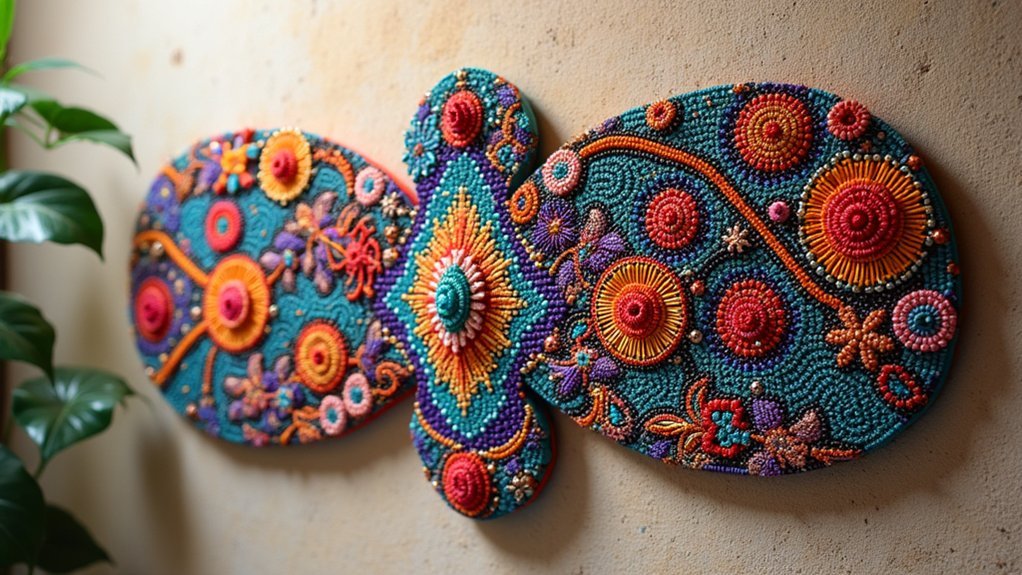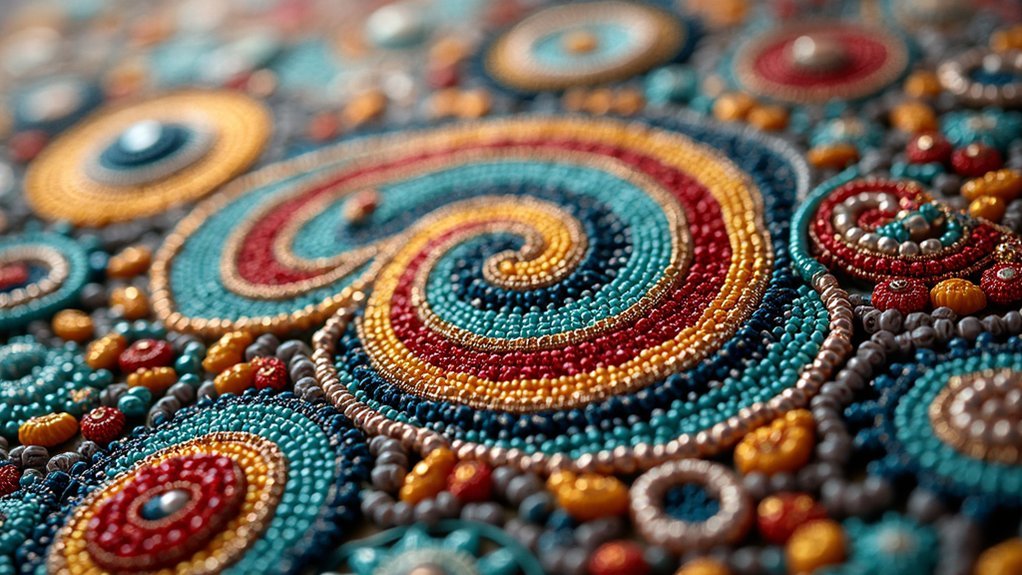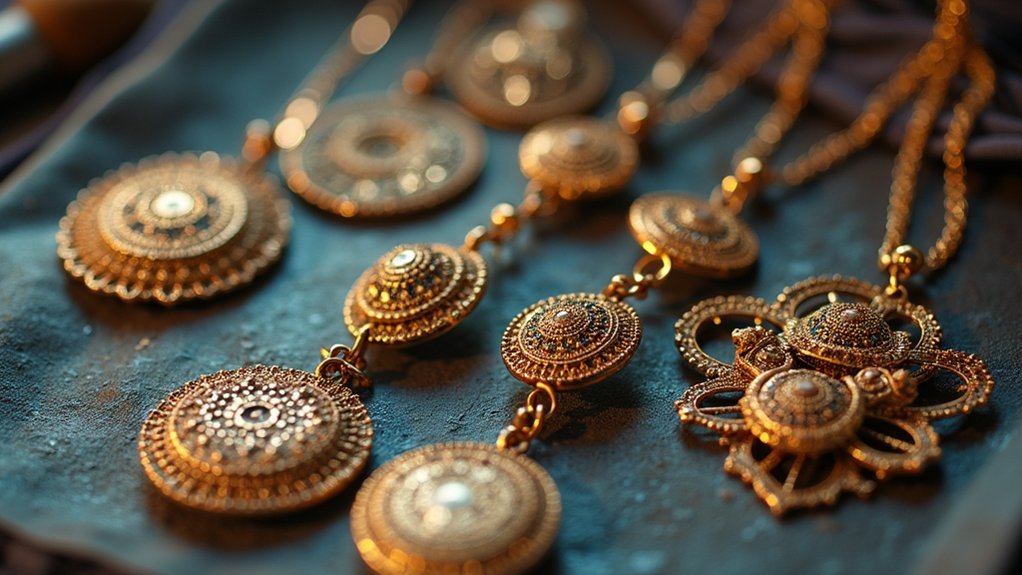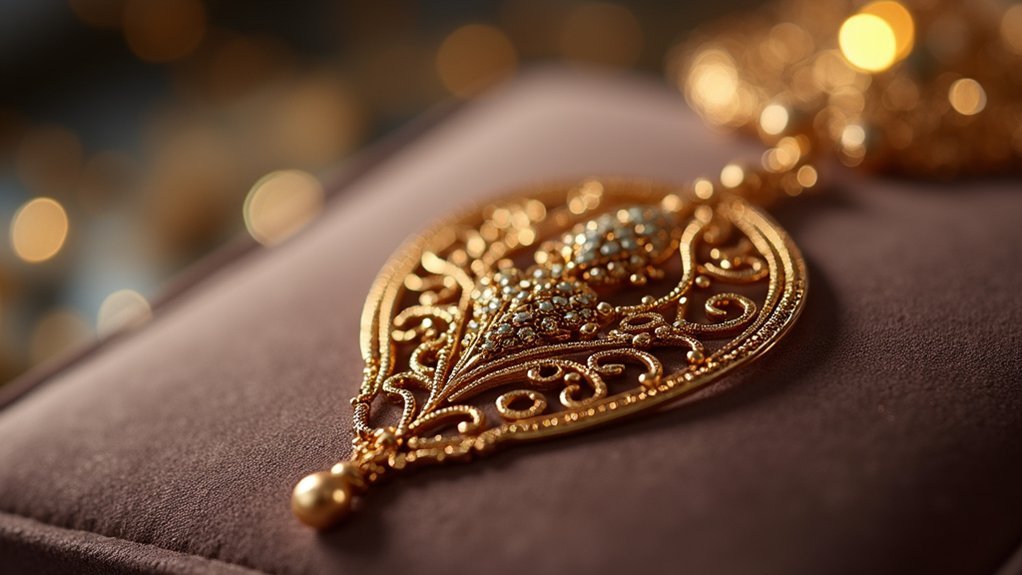Indigenous beadwork stretches across continents with diverse techniques and materials. You’ll find traditional artisans using shells, bones, and stones before European contact introduced glass beads. Each region develops distinctive styles—Huichol spiritual narratives, Navajo geometric patterns, and Maasai color symbolism. Beyond decoration, these intricate designs communicate cultural identity, family lineage, and spiritual connections. The contemporary renaissance blends ancestral techniques with modern themes, keeping ancient traditions vibrant while they continue to evolve across cultures.
From Earth to Adornment: Origins of Indigenous Beadcraft

Before glass beads transformed Indigenous artistry, ancient craftspeople turned to their surroundings for creative expression.
You’ll find that early beadwork incorporated bones, shells, stones, and wood—materials that offered both durability and beauty. Archaeological discoveries in places like Ontario reveal sophisticated craftsmanship predating European contact, with intricate designs carved into natural elements.
Indigenous artistic traditions evolved through drilling, carving, and dyeing techniques that breathed life into these natural materials.
Ancient wisdom transformed natural elements into art through skillful hands that drilled, carved, and dyed Earth’s gifts.
When glass beads arrived, artisans didn’t abandon their heritage—they adapted. Red cylindrical glass beads, for example, were integrated alongside traditional red siltstone beads, expanding their color palette while honoring cultural roots.
Each bead carries symbolic meanings, with patterns serving as vehicles for storytelling, preserving wisdom and identity through generations of Indigenous creative expression.
Symbolic Language: How Beads Tell Cultural Stories
Why do Indigenous beadwork patterns captivate viewers across generations? When you examine these intricate patterns, you’re witnessing a symbolic language where each bead speaks volumes about cultural stories, heritage, and identity. Indigenous beadwork transcends mere decoration—it’s a complex communication system conveying social status and spiritual beliefs.
| Symbol Type | Cultural Significance |
|---|---|
| Floral Patterns | Connection to land and medicine |
| Geometric Designs | Tribal affiliation and family lineage |
| Animal Motifs | Spiritual guides and clan identity |
| Color Combinations | Emotional meaning and seasonal significance |
Traditional techniques passed through generations preserve these narratives. Today’s contemporary artists honor ancestral methods while incorporating modern themes, ensuring the continuation of this rich heritage. When communities create beadwork, they’re not simply crafting art—they’re actively preserving their history through a timeless medium.
Regional Mastery: Distinctive Techniques Across Continents

The geographic diversity of Indigenous beadwork reveals itself through distinct regional techniques that have evolved across different continents. From the Huichol tribe’s intricate spiritual narratives to the Navajo’s geometric patterns in traditional jewelry, each indigenous community has developed unique approaches.
Indigenous beadwork flourishes in regional diversity, with each community’s distinct techniques telling unique cultural stories through intricate patterns and symbols.
You’ll find Maasai artisans employing color symbolism—red for bravery, blue for energy, white for purity—creating pieces that instantly communicate social status.
Native American beadwork techniques include loom weaving and embroidery, preserving their unique history through wampum belts that document treaties.
Meanwhile, Indian beadwork techniques culminate in items like the Mangal Sutra, where sacred beads reflect regional artistry.
These diverse approaches to cultural heritage demonstrate how indigenous communities worldwide have mastered beadwork to express their distinct identities through both technique and symbolism.
Evolution Through Trade: Material Exchanges and Innovation
When European traders first encountered Indigenous communities across continents, they unknowingly sparked a revolution in traditional beadwork that would transform artistic expression for centuries. You’ll find that Indigenous artisans masterfully incorporated new materials while preserving their cultural identity through time-honored techniques.
| Material | Origin | Impact on Indigenous Beadwork |
|---|---|---|
| Glass Beads | European Trade | Expanded color palette |
| Red Cylindrical Beads | European Glass | Replaced traditional siltstone |
| Shell/Bone | Pre-colonial | Foundation of heritage techniques |
| Modern Materials | Contemporary | Enables artistic innovation |
Archaeological evidence from Ontario confirms that Indigenous beadwork predates colonial contact, with artisans adapting European glass beads to mimic traditional materials. Today’s contemporary artists continue this legacy of material exchanges, creating innovative works that honor their heritage while embracing modern artistic traditions.
Contemporary Renaissance: Indigenous Beadwork in Modern Artistry

Across galleries and runways throughout the world, Indigenous beadwork has experienced a remarkable renaissance, with artists like Samuel Thomas and Catherine Blackburn transforming this ancestral craft into contemporary masterpieces.
You’ll notice how these contemporary Indigenous artists skillfully blend traditional beading techniques with modern themes, creating innovative pieces that honor their heritage while speaking to today’s audiences.
The introduction of glass beads has expanded color possibilities, enabling complex artworks that continue the tradition of storytelling and cultural expression. These pieces often reflect themes of resilience and identity.
Community initiatives and workshops guarantee these techniques pass to younger generations, preserving this essential art form.
Through exhibitions and online platforms, Indigenous beadwork is gaining deserved visibility and appreciation globally, establishing its rightful place in the contemporary art landscape.
Frequently Asked Questions
What Is the Significance of Beading in Indigenous Culture?
Beading in indigenous culture is significant because you’ll see it embodies cultural narratives, preserves heritage, marks social status, facilitates spiritual practices, connects generations, and showcases exceptional craftsmanship that’s been passed down through time.
What Is the Cultural Significance of Beadwork?
Beadwork carries deep cultural significance as you’ll find it preserves stories, traditions, and identity. It’s not just decorative art—it’s a visual language that connects you to ancestral wisdom and community heritage.
Which Ethnic Group Is Famous for Beadwork?
You’ll find that multiple ethnic groups are famous for beadwork, including the Huichol, Navajo, Maasai, and Lakota peoples. Each community creates distinctive styles that reflect their unique cultural traditions and spiritual beliefs.
What Native American Tribes Were Known for Beadwork?
You’ll find that several Native American tribes mastered beadwork, including the Navajo with their geometric designs, the Huichol with their spiritual imagery, the Miwok’s beaded basketry, and the Mapuche’s distinctive silver and bead jewelry.
In Summary
You’ve now glimpsed how indigenous beadwork transcends mere decoration, serving as visual chronicles of cultural resilience. When you encounter these intricate pieces, you’re witnessing living history—traditions that have adapted through centuries while maintaining their essence. Today’s indigenous artists aren’t just preserving heritage; they’re actively reimagining it, ensuring these meaningful practices continue to evolve and inspire across generations and borders.





Leave a Reply